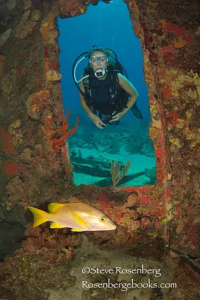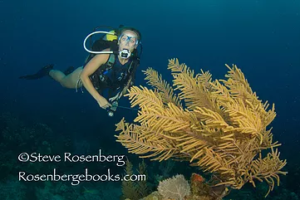The Plume of Death – Save Cayman’s Shallow Reefs
For those in the diving community who haven’t been paying attention, George Town Harbor and the surrounding area is currently the focus of a huge controversy regarding construction of a proposed cruise ship berthing facility (cruise ship pier) in Grand Cayman. The reasons given by the proponents of the plan seem to include peer envy and greed. Some politicians have stated that other Caribbean Islands, such as Cozumel, have cruise ship piers, so Cayman needs one in order to “keep up with the Jones’s.” Others contend that a cruise ship pier will bring more cruise ship passenger dollars to the island.
 The realty is that Cayman’s economy was built in large part upon tourism. One of the main attractions that Grand Cayman provides cruise ship visitors has historically been the warm clear water and the shallow reefs in and around George Town Harbor. Tourists have flocked to Cayman to dive, snorkel and participate in a myriad of water sports and other activities resulting from this natural resource.
The realty is that Cayman’s economy was built in large part upon tourism. One of the main attractions that Grand Cayman provides cruise ship visitors has historically been the warm clear water and the shallow reefs in and around George Town Harbor. Tourists have flocked to Cayman to dive, snorkel and participate in a myriad of water sports and other activities resulting from this natural resource.
If the cruise pier is constructed, the dredging and resulting silt plume will directly or indirectly devastate the shallow reef system from just north of the Lobster Pot Dive Center south to the near shore reefs along South Church Street. The extraordinary dive sites in this area include Soto’s Reef (Cheeseburger Reef), the Wreck of the Cali, Eden Rock, Devil’s Grotto, the Wreck of the Balboa and other reefs lying in and around George Town Harbor. The Wreck of the Balboa lies directly within the construction zone and these other reefs are located adjacent to the dredge pit. The silt resulting from the construction, the ongoing dredging and the constant bombardment of silt generated by the Cruise Ships’ prop wash will result in the corals and sponges being suffocated and destroyed, leaving behind a dead and lifeless reef system. Unlike other areas in the Caribbean such as Cozumel, George Town Harbor has no current, so there is no natural way to clear the cloud of silt from the area.
If this development is allowed to happen there will be no possibility of recovery. These amazing reefs, which are home to one of the largest aggregations of dwarf herring (Silversides) found anywhere in the Caribbean, will be destroyed. The incredible profusion of corals and sponges will disappear. The reality is that future generations will never be able to experience the incredible beauty of these historic and extraordinary dives sites.
 DEMA, the Dive Equipment and Marketing Association, has also recently weighed in with its opinion that “the construction and operation of this facility will be devastating to the natural coral reefs.” This is based in part on the Environmental Impact Statement commissioned by the Cayman Department of Environment, which found that severe damage would occur due to direct dredging action, turbidity and siltation on the shallow living reefs in and around the Georgetown during construction and additional damage would likely be caused by the on-going dredging required to maintain the berthing facility. It should also be noted that the economic data presented in the Environmental Statement, showed that the Proponent’s argument that ‘the construction of a cruise ship pier would result in an economic benefit to the Cayman Islands” appears to be questionable at best.
DEMA, the Dive Equipment and Marketing Association, has also recently weighed in with its opinion that “the construction and operation of this facility will be devastating to the natural coral reefs.” This is based in part on the Environmental Impact Statement commissioned by the Cayman Department of Environment, which found that severe damage would occur due to direct dredging action, turbidity and siltation on the shallow living reefs in and around the Georgetown during construction and additional damage would likely be caused by the on-going dredging required to maintain the berthing facility. It should also be noted that the economic data presented in the Environmental Statement, showed that the Proponent’s argument that ‘the construction of a cruise ship pier would result in an economic benefit to the Cayman Islands” appears to be questionable at best.
The proposal for the pier as presented, necessitated costs in the form of millions of dollars to re-locate a shipwreck (the Balboa) and portions of the living reef in the immediate area of the construction. The economic data as presented also pointed out that tourists arriving by air to the Cayman Islands (rather than cruise ship) account for 77% of the tourist revenue generated on the island. Given that fact, it appears to make little economic sense to destroy the very fabric of Grand Cayman’s attraction to tourists (the shallow living reefs), to accommodate a greater number of cruise ships ferrying tourists who, according the Environmental Statement, spend an average of less than $CI 100 per person on island. Furthermore, it appears likely that if the project goes ahead, the number of stay over tourists would actually decrease over the long run.
 It appears that the decision of whether or not to build the cruise ship pier will be a cabinet decision, so all of the legislative assembly members and ministers in the Cayman Government will vote. It should be noted that the daily administration of the islands is conducted by this Cabinet.
It appears that the decision of whether or not to build the cruise ship pier will be a cabinet decision, so all of the legislative assembly members and ministers in the Cayman Government will vote. It should be noted that the daily administration of the islands is conducted by this Cabinet.
A new grass roots group says it will take the fight against a cruise berthing facility to the voters if the cabinet moves forward with the plan. This group, savecayman.org, is hoping to force a referendum getting one quarter of the country’s registered voters on board to force a public vote. A referendum would require the approval of approximately 4600 registered voters to make that happen. That number is 25% of the existing registered voters
 (Caymanian status holders or Caymanians defined as Cayman born w/ Caymanian parents or grandparents) in the Cayman Islands. It would be a difficult task to assemble that amount of support, but such vote would only require a simple majority to reject the proposal. Sources close to the group have indicated that this effort may very well delay the outcome of this issue or perhaps force a compromise solution to be put in play.
(Caymanian status holders or Caymanians defined as Cayman born w/ Caymanian parents or grandparents) in the Cayman Islands. It would be a difficult task to assemble that amount of support, but such vote would only require a simple majority to reject the proposal. Sources close to the group have indicated that this effort may very well delay the outcome of this issue or perhaps force a compromise solution to be put in play.
The EIA, Environmental Impact Assessment, can be seen in its entirety on the website of the Department of Environment, www.doe.ky. For more information on what you can do, go to the savecayman.org website.



